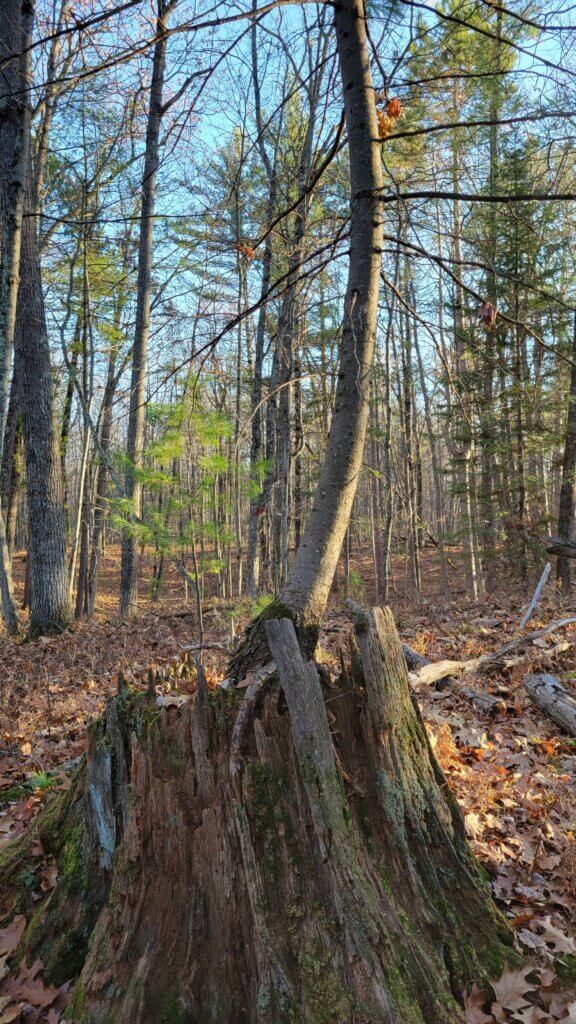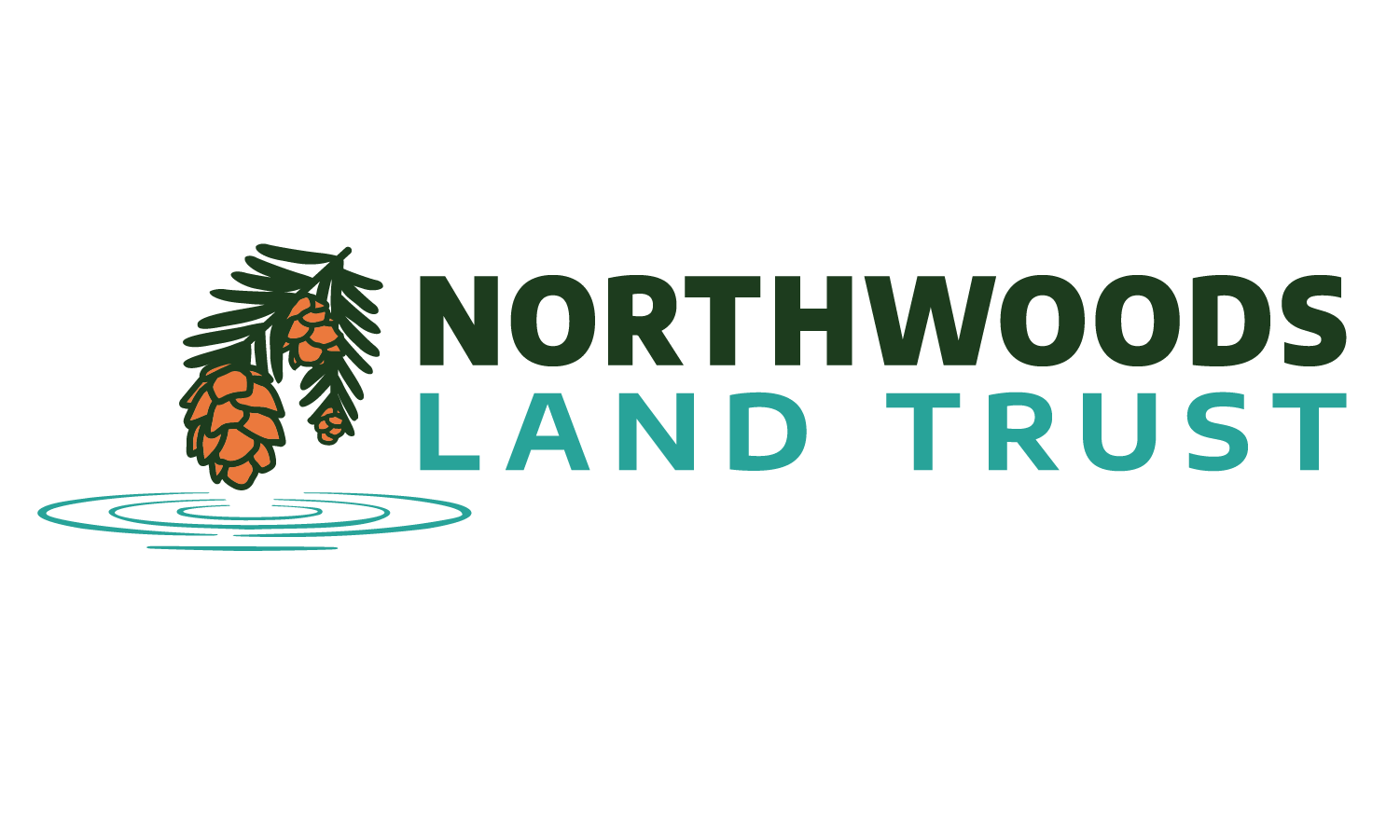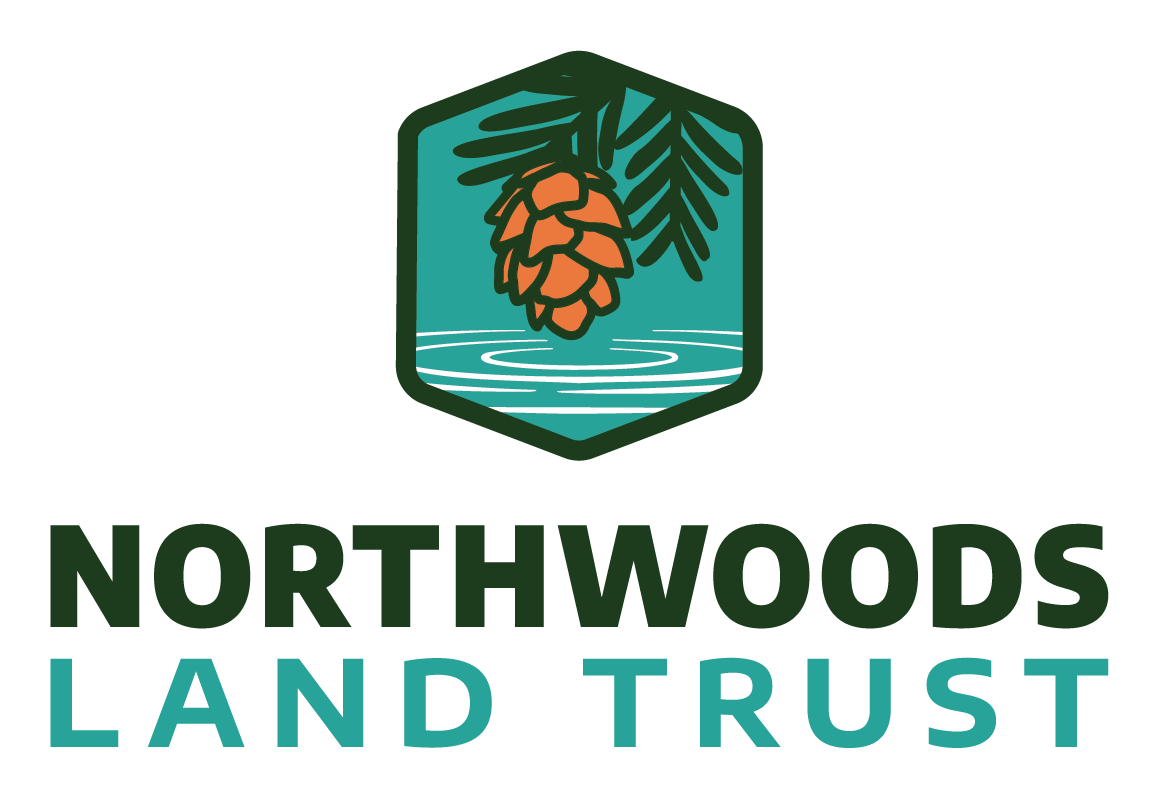Yawkey Forest Preserves History with an Eye Toward the Future
By Paul Strong, NWLT volunteer

Five plus years following the donation of the Yawkey Forest Reserve in Hazelhurst in Oneida County is a good time to take stock of the parcels that make up the reserve, their management, the treasures of the past they hold, and their contributions to future generations. The parcels that total 453 acres and over four miles of shoreline around Lake Katherine share an origin story but diverge over time due to natural features and the choices made by the Yawkey family and heirs that once owned them.
About 15,000 years ago and across all of northern Wisconsin, the last advance of glaciers caused forests and their plant and animal inhabitants to retreat to the south where environmental conditions allowed them to persist. As the glaciers receded to the north, a new varied landscape was born. In north-central Wisconsin, an area now known as the northern highlands was created, a low dome of sand and gravel interspersed with thousands of lakes and wetlands, and pockmarked with large and small pits, an area with far steeper slopes and small hills than one might imagine in a midwestern state.
Over the millennia, trees, other plants and animals returned creating a new forest assemblage dominated by red and white pine and northern red oak on upland sites and black spruce and tamarack in forested wetlands. Trembling and bigtooth aspen were common in upland areas disturbed by wind events and fires. Sugar and red maple along with eastern hemlock and yellow birch occupied cooler, shadier sites with slightly richer soils.
Aboriginal people were likely here continuously from the end of the last glacial period. This area was part of the homelands of the Ojibwe people (sometimes called Ojibway or Chippewa Indians). They would have foraged and hunted on the lands and speared fish in the lakes. Treaties with the U.S. Government in the mid-1800’s allowed non-tribal settlement, but tribes retained their rights to hunt, fish, and gather.
The extensive pine forests of Wisconsin’s Northwoods attracted lumber barons who bought up thousands of acres of land, established mills and railroads, and took out the large pines to create lumber for wood-hungry towns and cities to the south. In the Hazelhurst area in the late 1800’s and early 1900’s, the Yawkey – Lee and then Yawkey – Bissell companies actively procured trees and sawed lumber at the mill that once stood close to the current town-owned public landing, beach, and park on the Lake Katherine’s western shore. Some of the trees cut relatively close to Lake Katherine and nearby Lake Tomahawk were floated for their journey to the mill. The State legislature even passed a law in 1891 authorizing the company to construct a canal between the two large lakes to facilitate getting logs to the mill. For forests at greater distance, narrow gauge rail lines were laid down and a locomotive pulled rail cars stacked with large logs. By 1921, with the pine in the area largely cut out, the mill had shut down operations.
Around the same time, tourism was a growing activity in Wisconsin’s Northwoods with fishermen and city people seeking clean air and water, outdoor summer activities on lakes, and a peaceful and less noisy environment. Lake Katherine, a classic Northwoods lake nicknamed “Queen of Northern Lakes” was ideal with all of these features – oligotrophic (clear water with few weeds), spring fed (cold), good fishing – and easily accessible by railroad. In the early 1900’s, several resorts were established around the lake. Additionally, the Lake Katherine Improvement Company began developing and selling lake lots as well as building and selling homes and cabins for them. The Yawkey family kept specific areas of the lakeshore and several islands undeveloped despite the potential economic benefit. Some of these became the tracts now known as the Yawkey Forest Reserve.
It is difficult to imagine a landscape largely devoid of trees around a hundred years ago when looking at the forests of the Yawkey Forest Reserve today. A few areas had been spared from logging, but where tree harvests occurred, they typically went right to the lakeshore (no shoreline protection regulations at that time). Over the ensuing decades, the forests recovered mostly on their own. Small pines left behind turned into the large old sentinels of today. Aspen and oak became more common components. The maples, yellow birch, and hemlock decreased in numbers and locations. Thus, the forests on these lands are the first or second generation of cutover lands, but in one area a forest was left mostly undisturbed save for the forces of nature.
Many of the tracts of the Reserve are enrolled in the state’s Managed Forest Law program in which they have management plans developed and tree harvesting schedules established. For most tracts in the MFL, the goal is to have future forests dominated by white pine and northern red oak as was the case before the intensive logging era. These will provide many benefits in the future including supercanopy pines jutting above the surrounding treetops. The “skyscrapers” of northern forests are highly desired by bald eagles for roosts and nesting. Pines growing near or along the shoreline will also be desirable perching places for fish-eating birds like eagles, kingfishers, and ospreys, and as they grow old will be blown down or fall on their own into the lake creating a steady supply of durable and excellent hiding habitat for fish. Oak, a relatively long-lived tree, will provide acorns that are key, highly nutritious fall foods for black bear, wild turkeys, squirrels, some bird species, and deer. Careful planning and implementation of logging activities will start the process while providing wood fiber for local mills and tax relief for NWLT. Unlike in the old days, shoreline buffers where no harvest will occur will help retain scenic values, keep steep slopes from eroding into the lake, and allow trees there to grow older and larger benefitting the lake in several ways (for example, shade, fish habitat, and a source of nutrients from fallen leaves).
Three of the more than twenty Reserve tracts will not have logging activities. These are largely on or around Tigertail Point and the three islands. The Tigertail forests do not appear either to have been logged at all, or if so, lightly, and currently have several characteristics of old growth conditions including very large old pines and hemlocks, numerous standing and down dead trees.
As our climate continues to change, all forests will be stressed by temperature variability across seasons, episodic rain events, long dry periods, and ever-advancing non-native invasive species. It is hoped that the forests of the Reserve will be resilient to changes by having an assemblage of trees, shrubs, and understory plants that are native to the area.
Trees like yellow birch and hemlock, already set back by the effects of the logging era over a century ago and the browsing of an overabundant deer population, are at high risk to the effects of climate change and invasive insects. The hemlock woolly adelgid (insect) is advancing from the eastern part of the country and leaving hemlock skeletons in its wake. There are only a few places in the Reserve where these two tree species remain in any numbers. They tend to be where the aspect and curve of the shoreline creates a shady and cooler microenvironment. Tigertail Point is an important sanctuary for these two at-risk species.
A number of traipses I have made through most of the tracts reveal other remnants of the past, some from thousands of years ago and others from the settlement of the area just a century or so back. Naturally occurring conical pits called “kettles” dot some of the landscape. They were created as the glaciers ground into the earth and then receded. Small and large blocks of ice broke off and were left behind covered by soil. They melted slowly and eventually the soil above them collapsed forming the pit. Some of the kettles are quite large and deep. One, along the lake’s northern shore of Tomahawk Bay near the canal, is an oblong shape and at one end contains an extremely small bog – a most unusual land feature! Surprisingly steep slopes occur along much of the lakeshore and in a few upland areas. A large wetland, mostly expressed as a bog, includes a small pond, likely spring fed, with a flow to the lake (the lake’s only inlet).
Man-made features in the Reserve are largely linear – some straight and others serpentine. One relatively straight one is the old rail line that served the lumber mill in Hazelhurst. That line was separate from the nearby passenger rail line that was eventually abandoned and became the Bearskin Trail now administered by the Wisconsin DNR. The Yawkey – Bissell Company owned their own line, the Hazelhurst and Southeastern. Off that line were short spurs that allowed the train to pull into areas where trees were being cut and to back out and proceed down the line to the mill. That rail line was next to the old highway (before Highway 51 was constructed) on the south end of Lake Katherine and there were side-by-side bridges across the narrow section of the lake there.
A section of the old highway abandoned when Highway 51 was built (and rebuilt) lies on one of the tracts near the unofficial wayside and is still recognizable. It shows up again on the other side of Highway 51 on another tract just out of sight and mind of cars speeding along the highway. At the time, it brought passenger vehicles into Hazelhurst on what is now a side street before continuing on to Minocqua. Another travel way called the “Wagon Road” on old topographic maps from the 1930’s has abandoned sections on the tract on the very southern end of Lake Katherine. It is unclear what function this road served, but perhaps served a few landowners setting up homesteads there.
Throughout many tracts of the Reserve there are winding woods roads that were likely established when timber cutting occurred or afterwards when firewood gathering would have been a common activity. Most have almost disappeared and been absorbed into the surrounding landscape as trees and shrubs have grown in, but a keen eye can make them out. An occasional “treasure” can be found like the remains of an early model car sinking away into the earth, and a stroll along them evokes thoughts of earlier times.
It would be easy to ignore, forget, and undervalue the historic features contained in the Yawkey Forest Reserve. The progression of time and society have left them behind. For some, however, they can be the portal to understanding and appreciating the important early history of the area and an acknowledgment that the conservation work of the present and future is not to erase or condemn the past, but to use wisdom gained for a better and hopefully, sustainable future.


